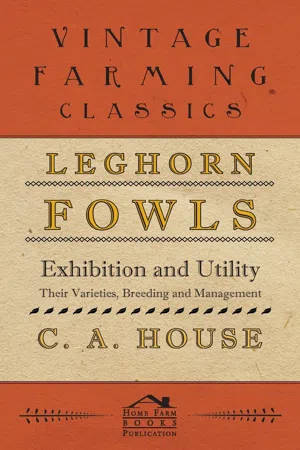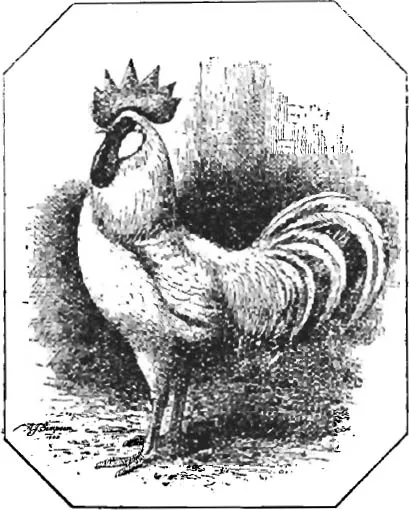![]()
CHAPTER II
THE WHITE
In dealing with the different varieties I take the White firs, not only because it was the firs of the family to come to this country, but because it is the mos widely known, and the mos popular both amongs exhibitors and utilitarians.
This variety has a specialis club to watch over its interess, and in the early part of 1926 it was re-organised, and one of its firs acions was to revise the old exhibition sandard, and at the same time it compiled a sandard for utility birds, being the firs specialis club to issue sandards for exhibition and utility. This it, no doubt, did because the White Leghorn is now so largely shown in utility classes at shows in all parts of the country.
These sandards have been generally approved and as they are to-day accepted by all breeders and judges I give them here.
THE EXHIBITION WHITE LEGHORN STANDARD OF PERFECTION
(Amended 1926)
COCK
Head and Neck
Beak.—Stout, the point sanding well clear of the front of the comb.
Comb.—Single and fine in texture denoting quality, proportionate in size and by no means over-grown, perfecly sraight and erec with serrations deep cut and even, the several spikes, from five to seven in number, being broad at the base and tapering perfecly to the points. The Comb should extend well beyond the back of the head, following without touching the line of the hackle; free from thumb marks or side sprigs.
Face.—Fine in texture, free from white, wrinkles, or fold. Wattles: Proportionately long, thin and fine in texture. A perfec pair in shape and size and folding back evenly from the front. Lobes: Proportionate in size, of fine texture and oval in shape, the wides part being at the point of attachment at the ear aperture, placed as to be well clear of the cheek of the face and tight fitting, even in size and shape and free from wrinkles or folds. Eye: Bold and full of fire, bright red in colour and suggesing vitality. Neck: Well arched and abundantly furnished with hackle plumage.
Body.—Wedge shaped, wide at the shoulders and narrowing to root of tail.
EXHIBITION WHITE COCKEREL
First and Special at the Crystal Palace
Bred and exhibited by Lord Dewar
A TYPICAL LEGHORN HEAD
One of Mr. I. B, Gow’s winning cockerels
THE IDEAL LEGHORN PULLET
THE IDEAL LEGHORN COCKEREL
Breast.—Round, full and prominent, keel deep, breas bone prominent, long and sraight.
Back.—Long, with an almos imperceptible slope to the tail.
Wings.—Long and full, well furnished with long wide flight feathers, and carried tightly tucked in at the sern.
Tail.—Sickle feathers long and wide and set in flat, each sickle being followed evenly by secondaries of silky texture and proportionate in length, the true tail feathers being set in the root of the tail flat as adverse to shuttle-cock fashion. The angle of the tail should be 45 degrees from the back.
Legs and Feet.—Legs: Of proportionate length and set on at outside of body, the bone of the shank being fine and round, covered with tight-fitting scales of fine texture, free from down or any semblance of feather. (N.B.—Any tendency to angular or flat shins to be srongly deprecated). Feet: Toes four in number, well spread, and perfecly sraight, conveying the impression of a firm and reliable sance.
Carriage and Style.—Indicating vigour, vitality and life in every movement. There should be no suggesion of siltiness, and the body should be carried horizontally, so as to give the necessary full round front and a true impression of Leghorntype.
Side.—Medium. (N.B.—Judges are requesed to give no encouragement to mere size, and any tendency to coarseness in any direcion should be regarded as a departure from true Leghorn character and treated accordingly.)
HEN
Head and Neck.—Beak, Wattles, Face, Eye, Lobes and Neck: As in Cock. Comb: Single and fine in texture denoting quality, proportionate in size and by no means over-grown, serrations deeply cut, the several spikes, from four to six in number, being broad at the base and tapering perfecly to the points, free from side sprigs, and falling gracefully over from the base to either side of the face.
Body.—Wedge shaped, wide at the shoulders and narrowing to some little extent to root of tail as in Cock.
Breast.—Round, full and prominent, keel deep, breas bone prominent, long and sraight as in Cock.
Back.—Long, with an almos imperceptible slope to tail.
Wings.—As in the Cock.
Tail.—Of proportionate length, moderately full, and carried fairly close at an angle of 30 degrees or lower for preference.
Legs and Feet.—As in the Cock.
Carriage and Style.—Description of Cock applies.
Side.—As in the Cock.
COLOUR IN WHITE LEGHORNS
In both Sexes.—Beak and Legs: Bright yellow. Eye: Brilliant red. Comb and Wattles: Healthy rosy red. Face: Bright fresh red, without any trace of white. Lobes: White or slightly cream, the former preferred. Toe-Nails: White or cream colour. Plumage: Pure white. Any tendency to sraw colour to be deprecated. (N.B.—In esimating colour value judges should not overlook the difference in importance of fixed sraw colour to natural sap which may be due to feather immaturity. The latter should be regarded as a much less serious fault than the former.)
VALUE OF POINTS IN WHITE LEGHORNS
DEFECTS IN WHITE LEGHORNS
Serious Defects for which a Specimen should be passed.—Cock’s comb twised or falling over, or Hen’s comb erc; ear lobe red, any white in face; legs any colour but yellow; wry or squirrel tail; any serious physical deformity or positive departure from what is universally regarded as correc Leghorn type.
THE UTILITY WHITE LEGHORN STANDARD
(Approved by the Standard Committee of the National Utility Poultry Society.)
COCK
Head and Neck
Beak.—Stout, the point sanding well clear of the front of comb.
Comb.—Single, and fine in texture denoting quality, proportionate in size, and by no means over-grown, perfecly sraight and erec, with serrations deep cut and even, the several spikes, from five to seven in number, being broad at the base and tapering perfecly to the points. The Comb should extend well beyond the back of the head, following without touching the line of the hackle; free from thumb marks or side sprigs.
Face.—Fine in texture, free from white, wrinkles or folds.
Wattles.—Proportionately long, thin and fine in texture. A perfec pair in shape and size, and folding back evenly from the front.
Lobes.—Proportionate in size, of fine texture, and oval in shape, the wides part being at the points of attachment and the ear aperture, placed so as to be well clear of the cheek of the face and tight fitting, even in size and shape, and free from wrinkles or folds.
Eye.—Large, bold, prominent, and full of fire.
Neck.—Proportionate in length, well arched, and abundantly furnished with hackle plumage.
Body.—Wedge shaped, of good width and depth, broad and square shoulders, with a gradual tapering to the root of tail.
Breast.—Round, full and prominent, keel deep, breas bone prominent, long and sraight.
Back.—Proportionately long and free from roundness, good width at shoulders, and proportionately tapering to root of tail.
Wings.—Proportionate in length and full, well furnished with long wide flight feathers, and carried tightly tucked in at the sern.
Tail.—Sickle feathers long and wide and set in flat, each sickle being followed evenly by secondaries of silky texture and proportionate in length, the true tail feathers being set in the root of the tail flat as adverse to shuttle-cock fashion. The angle of the tail should be 45 degrees from the back.
Legs and Feet.—Legs of proportionate length, and not too long in thigh, set on at outside of body, the bone of the shank being of fine quality and round, covered with tight fitting scales of fine texture, free from down or any semblance of feather. (N.B.—Any tendency to angular or flat shins to be srongly deprecated.)
Feet.—Toes four in number, well spread and perfecly sraight, conveying the impression of a firm and reliable sance.
Carriage and Style.—Well balanced, indicating vigour, vitality and life in every movement. The body should be carried so as to give the necessary full round front and perfec balance of true Leghorn type.
Size.—Medium. N.B.—Judges are requesed to give no encouragement to mere size and any tendency to coarseness in any direcion should be regarded as a departure from the true Leghorn characer and treated accordingly.
In the same way, ultra-fineness or meanness, resulting in an under-sized bird mus be regarded as a departure from true Leghorn type, and should be severely depreca...





